Sigma I Series Field Test: Hands-on with Sigma’s premium and compact 24mm f/3.5, 35mm f/2 and 65mm f/2 DG DN C lenses
posted Thursday, February 18, 2021 at 12:39 PM EST
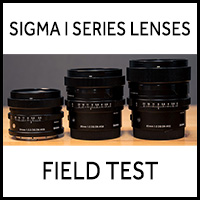
Sigma's new I Series of lenses offers customers premium compact lenses for E mount and L mount mirrorless cameras. There are currently four lenses in the series, each featuring an all-aluminum exterior, magnetic lens cap, and impressive build quality at relatively affordable prices. Sigma promises customers that I Series lenses are both compact and durable while also delivering excellent image quality. Does Sigma achieve its lofty goal?
I have gone hands-on with three of Sigma's four I Series lenses, the new 24mm f/3.5 DG DN C, 35mm f/2 DG DN C, and 65mm f/2 DG DN C. This trio of lenses was announced at the same time, so it seemed the perfect opportunity to field-test all of them simultaneously. I used the 35mm and 65mm primes with the Sony A7R IV. The 24mm f/3.5 arrived shortly after in L-mount, and so I shot the widest I Series lens with a Panasonic S1.
Sigma 24mm f/3.5 DG DN C Key Features
- 84.1-degrees angle of view
- 10 elements in 8 groups
- Includes 1 SLD glass element and 3 aspherical lens elements
- Includes Super Multi-Layer coating
- Compatible with high-speed autofocus and lens-based optical correction
- On Sony, supports DMF and AF+MF
- Minimum focusing distance is 4.3" (10.8 cm), resulting in 1:2 max magnification
- Includes autofocus stepping motor
- Dust- and splash-proof design
- Weighs 7.9 oz. (225g)
- D x L: 2.5" x 1.9" (64 x 48.8mm) for L mount, 2.5" x 2" (64 x 50.8mm) for E mount
- Includes integrated aperture control ring and focus mode switch
- Comes with metal lens hood and magnetic lens cap
- $549
Sigma 35mm f/2 DG DN C Key Features
- 63.4-degrees angle of view
- 10 elements in 9 groups
- Includes 1 SLD glass element and 3 aspherical lens elements
- Includes Super Multi-Layer coating
- Compatible with high-speed autofocus and lens-based optical correction
- On Sony, supports DMF and AF+MF
- Minimum focusing distance is 10.6" (27 cm), resulting in 1:5.7 max magnification
- Includes autofocus stepping motor
- Dust- and splash-proof design
- Weighs 11.5 oz. (325g)
- D x L: 2.8" x 2.6" (70 x 65.4mm) for L mount, 2.8" x 2.7" (70 x 67.4mm) for E mount
- Includes integrated aperture control ring and focus mode switch
- Comes with metal lens hood and magnetic lens cap
- $639
Sigma 65mm f/2 DG DN C Key Features
- 36.8-degrees angle of view
- 12 elements in 9 groups
- Includes 1 SLD glass element and 2 aspherical lens elements
- Includes Super Multi-Layer coating
- Compatible with high-speed autofocus and lens-based optical correction
- On Sony, supports DMF and AF+MF
- Minimum focusing distance is 21.7" (55 cm), resulting in 1:6.8 max magnification
- Includes autofocus stepping motor
- Dust- and splash-proof design
- Weighs 14.3 oz. (405g)
- D x L: 2.8" x 2.9" (72 x 74.7mm) for L mount, 2.8" x 3" (72 x 76.7mm) for E mount
- Includes integrated aperture control ring and focus mode switch
- Comes with metal lens hood and magnetic lens cap
- $699
Lens design and handling
All I Series lenses have the same general design and appearance. The three primes I used are only distinguishable by their sizes, or, in the case of the 24mm lens, the petal-shaped lens hood.
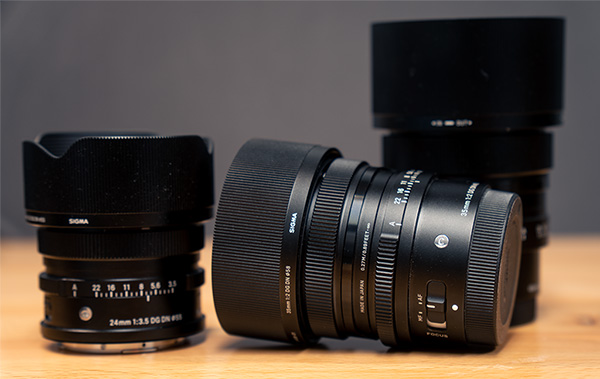
Each lens has an aluminum lens barrel, which gives the lenses a high-end look and feel. The lenses are black, very stylish and thoughtfully crafted. A relatively small detail that impressed me is that the metal lens hoods have a ridged surface, making them easier to grip. Each lens comes with a standard plastic lens cap and a second magnetic metal lens cap, which works well and is a nice, premium touch.
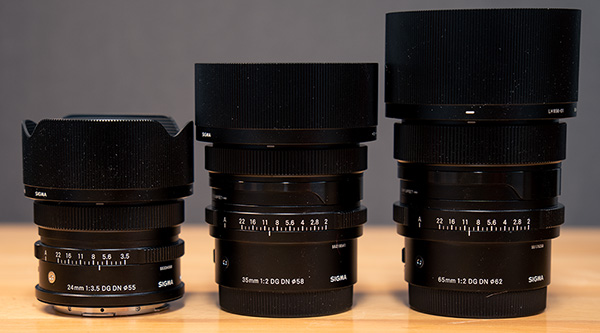
The lenses have an MF/AF switch near the lens mount. The focus rings are slightly different widths across the three lenses, but each has the same smooth rotation with just the right amount of resistance. The focus rings include a deeply ridged surface for grip.
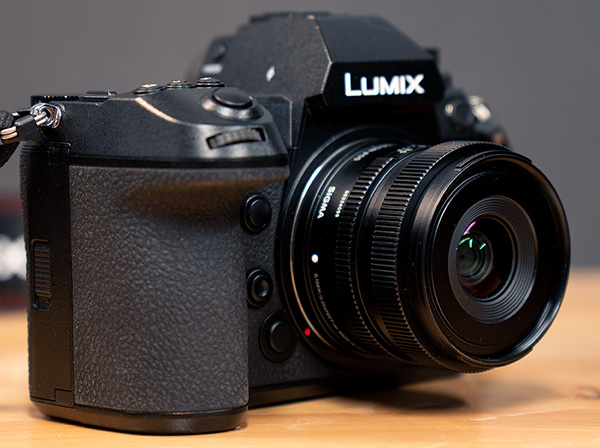
The I Series lenses include dedicated aperture rings, which are ridged in each case. The aperture ring is marked in 1/3 stops, with each full stop being labeled. It's easy to read, and the aperture rings work well. If you want to control the aperture via the camera, you can set the aperture ring to a separate 'A' setting. There's a healthy amount of resistance when switching from f/22 over to the 'A' position.
In terms of size and weight, all three lenses are quite compact for their respective focal lengths and maximum apertures. The 24mm f/3.5 is the lightest of the trio I used, weighing a mere 7.9 oz. (225g). The lens is about 2" (around 50mm) long in E and L mount and has a maximum diameter of 2.5" (64mm). The 35mm f/2 and 65mm f/2 lenses are both a bit larger. The 65mm lens is slightly longer than the 35mm lens at around 3" (75mm) and weighs 14.3 oz., about 3 oz. (around 80g) more than the 35mm.
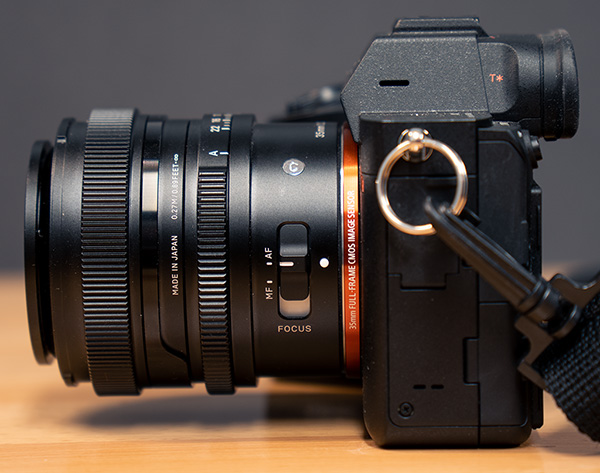
When paired with the Sony A7R IV, the Sigma 35mm f/2 and 65mm f/2 lenses balance well. The focus switch on each lens is easy to reach, and the focus rings are in comfortable locations. The same is true with the 24mm f/3.5 lens on the S1.
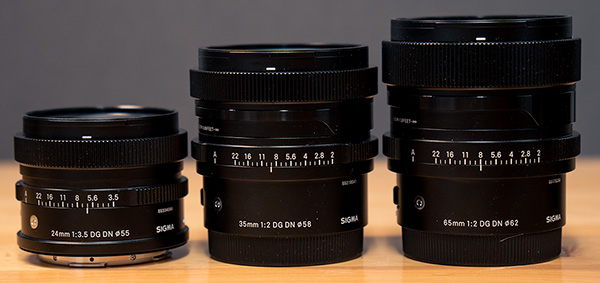
Overall, the Sigma I Series lenses I tested all exhibit great build quality, good handling and high-end style.
Image quality and performance
Sigma 24mm f/3.5
The Sigma 24mm f/3.5 DG DN C lens incorporates 10 elements in 8 groups, including an SLD glass element and 3 aspherical lens elements. The resulting image quality is good regarding sharpness, even when shooting the lens wide open.
At f/3.5, center sharpness is impressive. There are good detail and contrast, especially in the central portion of the frame. Corner sharpness is good, too. The lens doesn't show much in the way of chromatic aberrations or issues with color fringing.
By stopping down the lens, sharpness doesn't change very much in the center of the frame, which is to say that it's still good. In the corners, sharpness improves a bit, such that it's noticeable.
The bigger difference when stopping the lens down concerns the vignette. When shooting at f/3.5 and even at f/8, there's a noticeable vignette. As you can see in the full test scene above and the corner crops, the corners of the frame are significantly darker than the center. This is not a huge issue, as it can be corrected easily during processing, but it's nonetheless worth pointing out, as the vignette is easily observed.
Returning to sharpness, the lens is sharp up through f/11. Even at f/16, there is still pretty good detail, although diffraction-related softening is noticeable.
Overall, the Sigma 24mm delivers good image quality in nearly all aspects. The lens is sharp and exhibits good control of aberrations. Poor vignette control is the only negative aspect of the lens.
Sigma 35mm f/2
The Sigma 35mm f/2 DG DN C lens also includes an SLD element and 3 aspherical lens elements among its 10 total elements. And like the 24mm lens, optical performance is good.
At f/2.0, the center of the frame exhibits good sharpness and detail. There is some slight purple fringing around high-contrast fine details, and the image, in general, has just a bit less contrast than the same scene at f/2.8. Nonetheless, center sharpness is impressive. Corner performance is noticeably softer, and like with the 24mm lens, there's some vignette.
At f/2.8, the lens is just a bit sharper, with the scene overall showing excellent detail and contrast. The issue with purple fringing is also basically solved at f/2.8. Corner performance is also noticeably improved by stopping down to f/2.8.
Up to f/8, sharpness remains excellent. When stopped down further to f/11, the lens is slightly softer. At f/16, diffraction is noticeable, and at the minimum aperture of f/22, the lens is very soft.
With its maximum aperture of f/2, and fantastic performance at f/2.8, the 35mm is a fine, albeit slightly long, lens for night sky photography. The lens shows good control of comatic aberration. In the image below, you can see that there's almost no blob-like quality to the stars.
Overall, the Sigma 35mm f/2 lens is an impressive performer. The lens is sharp at f/2.0 and very sharp at f/2.8-8. Corner sharpness is okay at f/2 and good at f/2.8. The lens lacks a bit of punch wide open and displays some fringing but is otherwise a strong performer across the board.
Sigma 65mm f/2
The Sigma 65mm f/2 DG DN C lens has a dozen elements in nine groups. It has a single SLD element and a pair of aspherical lens elements. The lens is very sharp wide open in the center of the image area.
At f/2, corner detail is okay, although noticeably soft. Compared to the 35mm lens, the 65mm lens has better control over fringing and aberrations when wide open.
When stopped down to f/2.8, the lens is a bit sharper, and the image has more contrast. Corner performance is also improved slightly. At f/4-f/8, the lens is extremely sharp in the center of the frame. Corner performance also improves slightly as the lens is stopped down.
Diffraction is slightly noticeable at f/11 and very noticeable at f/16 and f/22. Granted, it's unusual to stop a 65mm fast prime lens down that much, so it's unlikely to matter for most users. It's also true that corner performance, in general, is less important for a fast mid-telephoto prime lens than something like the 24mm and 35mm primes, but the 65mm lens still has good corner performance nonetheless, when it's needed.
The Sigma 65mm f/2 lens has good bokeh performance, as well. The 35mm f/2 also does, to a lesser extent, but the combination of a longer focal length range and the same fast aperture makes the 65mm a better option for portraiture. The close focus distance is not great, but you can still fill the frame in many cases. The bokeh has a soft, pleasing appearance, and there's a smooth transition from in-focus to out-of-focus areas. For its price, the Sigma 65mm f/2 is a great choice for portraiture.
Autofocus performance
Each lens incorporates an autofocus stepping motor and delivers quick and quiet autofocus performance. Autofocus all proved accurate during my testing, even when shooting in low light. Of course, some of this may well come down to the Panasonic S1 and Sony A7R IV cameras being excellent. Still, nonetheless, autofocus performance with the trio of I Series lenses is good.
Manually focusing with each lens is also a good experience. The focus rings work well and have a great feel. The 35mm f/2 did act a bit odd when doing night sky photography, as I found that infinity focus is quite a bit short of where infinity is noted on the A7R IV's focus scale. It took a while to dial in focus. It's not unusual for infinity focus to not be located precisely on a focus scale, but the 35mm f/2 is about as far off as any lens I recall using. Nonetheless, the focus rings deliver good resistance and a quality feel.
In the Field with the Sigma I Series lenses
I enjoyed my time with each lens. They each offer something a bit different while delivering consistent optical performance across the board. There's something appealing about working with a cohesive 'set' of lenses, although I doubt that many photographers will purchase all the available I Series lenses.
The I Series are not able to match the best professional-oriented prime lenses when it comes to overall image quality. However, they offer great value, and the lenses have a high-end feel and performance. They're also each relatively compact, making it easy to carry them in a small bag.
I like each lens, but I enjoyed working with the Sigma 35mm f/2 lens the most. It is a good focal length for many different situations, and the f/2 maximum aperture gives it considerable versatility and flexibility. That said, for landscapes, the 24mm f/3.5 is a solid choice, as you typically won't need a fast aperture in this situation.
Sigma 24mm f/3.5 DG DN C Field Test Summary
What I like most:
- Excellent build quality
- Compact and lightweight
- Can focus closely
What I dislike:
- A lot of vignetting
Sigma 35mm f/2 DG DN C Field Test Summary
What I like most:
- Excellent build quality
- Good sharpness
- Performs well in many situations
What I dislike:
- Some aberrations and fringing at f/2.0
Sigma 65mm f/2 DG DN C Field Test Summary
What I like most:
- Excellent build quality
- Great sharpness
- Good bokeh
What I dislike:
- Close focus performance leaves a bit to be desired
The Sigma I Series lenses I tested are all great. Each lens has many strengths and relatively few weaknesses. All three lenses are built well, and the image quality performance ranges from good to excellent. If you're looking for an affordable, compact prime lens for your L mount or E mount camera, the Sigma I Series lenses are great options.






































